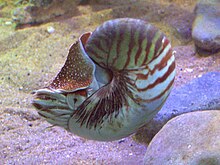Nautilida
| Nautilida Temporal range:
| |
|---|---|

| |
Nautilus pompilius
| |
| Scientific classification | |
| Domain: | Eukaryota |
| Kingdom: | Animalia |
| Phylum: | Mollusca |
| Class: | Cephalopoda |
| Subclass: | Nautiloidea |
| Order: | Nautilida Agassiz, 1847 |
| Type species | |
| N. pompilius | |
| Superfamilies | |
The Nautilida constitute a large and diverse order of generally coiled nautiloid
Classification and phylogeny
Current classification
The current classification of the Nautilida, in prevalent use,[1] is that of Bernhard Kummel (Kummel 1964) in the Treatise which divides the Nautilida into five superfamilies, the Aipocerataceae, Clydonautilaceae, Tainocerataceae, and Trigonocerataceae, mostly of the Paleozoic, and the later Nautilaceae. These include 22 families and some 165 or so genera (Teichert and Moore 1964)
Other concepts
Shimansky 1962 (in Kummel 1964) divided the Nautilida into five suborders, the mostly Paleozoic
. These include superfamilies which are different from those of Kummel (1964) and of less extent. The Centroceratina are comparable to the Trigonocerataceae, the Liroceratina to the Clydonautilaceae, and the Nautilina to the Nautilaceae. The main difference is that the Rutoceratidae are included with the Aipocerataceae of Kummel (1964) in the Rutoceratina. The remaining Tainocerataceae are the Tainoceratina.Derivation and evolution
Both Shimansky and Kummel derive the Nautilida from the Oncocerida with either the Acleistoceratidae or Brevicoceratidae (Teichert 1988) which share some similarities with the Rutoceratidae as the source. The Rutoceratidae are the ancestral family of the Tainocerataceae and of the Nautilida (Kummel 1964) and of Shimansky's and Teichert's Rutoceratina.
The Tainocerataceae gave rise, probably through the ancestral Rutoceratidae, to the Trigonocerataceae and Clydonautiliaceae in the Devonian and to the Aipocerataceae early in the Carboniferous. The Trigonocerataceae, in turn, gave rise late in the Triassic through the Syringonautilidae to the Nautilaceae, which include the Nautilidae, with Nautilus. (Kummel 1964)
Diversity and evolutionary history

The Nautilida are thought to be derived from either of the oncocerid families, Acleistoceratidae or Brevicoceratidae (Kummel 1964; Teichert 1988), both of which have the same sort of shells and internal structure as found in the Devonian Rutocerina of Shimanskiy, the earliest true nautilids. Flower (1950) suggested the Nautilida evolved from the Barrandeocerida, an idea he came later to reject in favor of derivation from the Oncocerida. The idea that the Nautilida evolved from straight-shelled ("Orthoceras") nautiloids, as proposed by Otto Schindewolf in 1942, through transitional forms such as the Ordovician Lituites can be rejected out of hand as evolutionarily unlikely. Lituites and the Lituitidae are derived tarphycerids and belong to a separate evolutionary branch of nautilioids.
The number of nautilid genera increased from the Early Devonian to about 22 in the Middle Devonian. During this time, their shells were more varied than those found in species of living Nautilus, ranging from curved (cyrtoconic), through loosely coiled (gyroconic), to tightly coiled forms, represented by the Rutoceratidae, Tetragonoceratidae, and Centroceratidae.
Nautilids declined in the
Despite again decreasing in diversity in the Permian, nautilids were less affected by the
For the remainder of the Mesozoic, nautilids once again flourished, although never at the level of their Paleozoic glory, and 24 genera are known from the Cretaceous. Again, the nautilids were not as affected by the end Cretaceous mass extinction as the Ammonoids that became entirely extinct, possibly because their larger eggs were better suited to survive the conditions of that environment-changing event.
Three families and at least five genera of nautilids are known to have survived this crisis in the history of life. There was a further resurgence during the Paleocene and Eocene, with several new genera, the majority of which had a worldwide distribution. During the Late Cretaceous and Early Tertiary, the Hercoglossidae and Aturiidae again developed sutures like those of Devonian goniatites. (Teichert 1988, pp. 43–44)
The recent decrease in the once worldwide distribution of nautilids is now believed to have been caused by the spread of pinnipeds.[2] From the Oligocene onward, the appearance of pinnipeds in the geological record of a region coincides with the disappearance of nautilids from that region.[3] As a result, nautilids are now limited to their current distribution in the tropical Indo-Pacific ocean, where pinnipeds are absent.[2] The genus Aturia seem to have temporarily survive regions where pinnipeds were present through adaptations to fast and agile swimming, but eventually went extinct as well.[3] Predation by short-snouted whales and the development of OMZs, preventing nautilids from retreating into deeper water, are also cited as other potential causes of extinction.[3]
References
- ^ Paleobiology Database
- ^ a b "How seals made Nautilus a 'Living Fossil'". Journal of Biogeography. 2022-10-15. Archived from the original on 2022-10-23. Retrieved 2023-03-29.
- ^ ISSN 0305-0270. Archived from the originalon 2022-10-25.
- Fenton and Fenton (1958), The Fossil Book (Doubleday & Co., Garden City, New York).
- Kümmel, B. (1964) "Nautilida" in Treatise on Invertebrate Paleontology, Part K. Mollusca 3. (Geological Society of America, and University of Kansas Press).
- Moore, Lalicker and Fischer, (1952) Invertebrate Fossils, McGraw-Hill Book Company, Inc., New York, Toronto, London.
- Teichert, T. (1988) "Main Features of Cephalopod Evolution", in The Mollusca vol. 12, Paleontology and Neontology of Cephalopods, ed. by M.R. Clarke & E.R. Trueman, Academic Press, Harcourt Brace Jovanovich.

